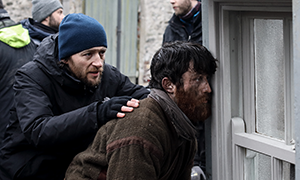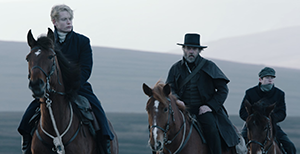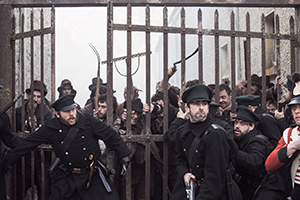Black ’47
Published in Issue 3 (May/June 2018), Reviews, Volume 26Fasnet Films, directed by Lance Daly
By Emily Mark-FitzGerald

Above: Director Lance Daly gives instructions to James Frecheville, who plays the film’s central character, Martin Feeney, a Connaught Ranger who has deserted his regiment and returned home in 1847 to find family and community in utter collapse.
Those in search of a forensic investigation of the political or economic history of the Famine had best look elsewhere; this is a film aimed squarely at a mainstream audience, yet it is a gripping story told with style and building tension. The film’s chief protagonist is Martin Feeney, a Connaught Ranger who has deserted his regiment and returned home in 1847 to find family and community in utter collapse. Played with stoic impassivity by James Frecheville, Feeney embarks on a methodical and escalating campaign of revenge that brings him into conflict with the recalcitrant Inspector Hannah (Hugo Weaving), a former British soldier and brother-in-arms with Feeney in Afghanistan. Hannah is forced to track Feeney down to avoid a death sentence for his own brutal killing of a prisoner in custody, and Weaving ably carries the film with lines delivered in a menacing growl, matched by Brian Byrne’s ominous score. The linear unfolding of Feeney’s wrath, paralleled by Hannah’s moral conflict as he pursues his prey across a ravaged landscape, is punctuated by brutalities visited upon both Famine villains and the innocent poor before culminating in a climactic denouement.
Hannah’s growing ambivalence towards his task is thrown into relief by his companion, the arrogant and youthful Captain Pope (Freddie Fox). Class distinctions between the two Englishmen are cleverly signalled through accent, manner and their divergent military pasts. Pope’s disdain for the country and its inhabitants is established in a scene in a train carriage, where he delivers his sneering version of political economy to an earnest but easily cowed journalist travelling west to cover unfolding events. Pope and Hannah are joined by young Private Hobson (Barry Keoghan), whose naïvety and complicity in suffering are gradually shattered, although his character is the least defined of the core ensemble.

Above: The pursuing ‘posse’ (left to right)—Captain Pope (Freddie Fox), Inspector Hannah (Hugo Weaving) and Private Hobson (Barry Keoghan).

Above: A food riot outside the gates of the ‘big house’, demonstrating strong visual correspondences with contemporary illustrated journalism.
Yet this is not a film without nuance. Black ’47’s use of the Irish language is sustained and strategic but not tokenistic, creating moments of empathy and communion between characters, and registers at the film’s climax as a metaphor for cultural survival against foreign incursions. Intriguing, too, is the choice to visit the most extreme violent retribution on the figure closest in class and kinsmanship to Feeney himself. The depravity of the gombeen-man ruthlessly profiting from the misery of his own kind has long figured in Irish popular culture. Here, however, its exposure relies on a shocking and horrific inversion of the pig as symbol of the Irish peasantry, more typically utilised in racist Victorian anthropomorphic caricature.
In some respects Black ’47 relies upon familiar tropes of Famine representation, especially evident in the strong visual correspondences with contemporary illustrated journalism, with its monochrome palette in the opening sequences cleverly echoing the stark graphic renderings of 1840s wood-engraving. Nevertheless, its ambition and cinematic polish distinguish the film from earlier attempts to capture the Famine on screen, which range from the melodramatic silent Knocknagow (1918) to the BBC/RTÉ co-production of The Hanging Gale (1995).
Eagle-eyed viewers will note a few historical missteps: the Connaught Rangers (88th Regiment of Foot) never fought in Afghanistan; ex-soldier Hannah would have had little reason to murder a captive Young Irelander in 1847, since their recourse to violent rebellion didn’t occur until 1848; and soup-kitchen relief is conflated with ‘taking the soup’ in both dialogue and in the depiction of a Protestant missionary cajoling the starving into conversion in exchange for food. None of these seriously detract from the force of the film, whose slow-burn pacing, tightly delivered performances and cliff-hanger ending are ultimately absorbing and highly watchable.
In delivering imagined forms of justice for Famine atrocities, Black ’47 inserts heroism into a period when this was in short supply, suggesting unfulfilled desires for redemptive narratives. Undoubtedly it will play particularly well among the diaspora, but director Lance Daly has produced a thoroughly contemporary, well-crafted Irish film inflected with nods to its genre that deserves a wide audience.
Emily Mark-FitzGerald is Associate Professor of Art History and Cultural Policy at University College Dublin.
















